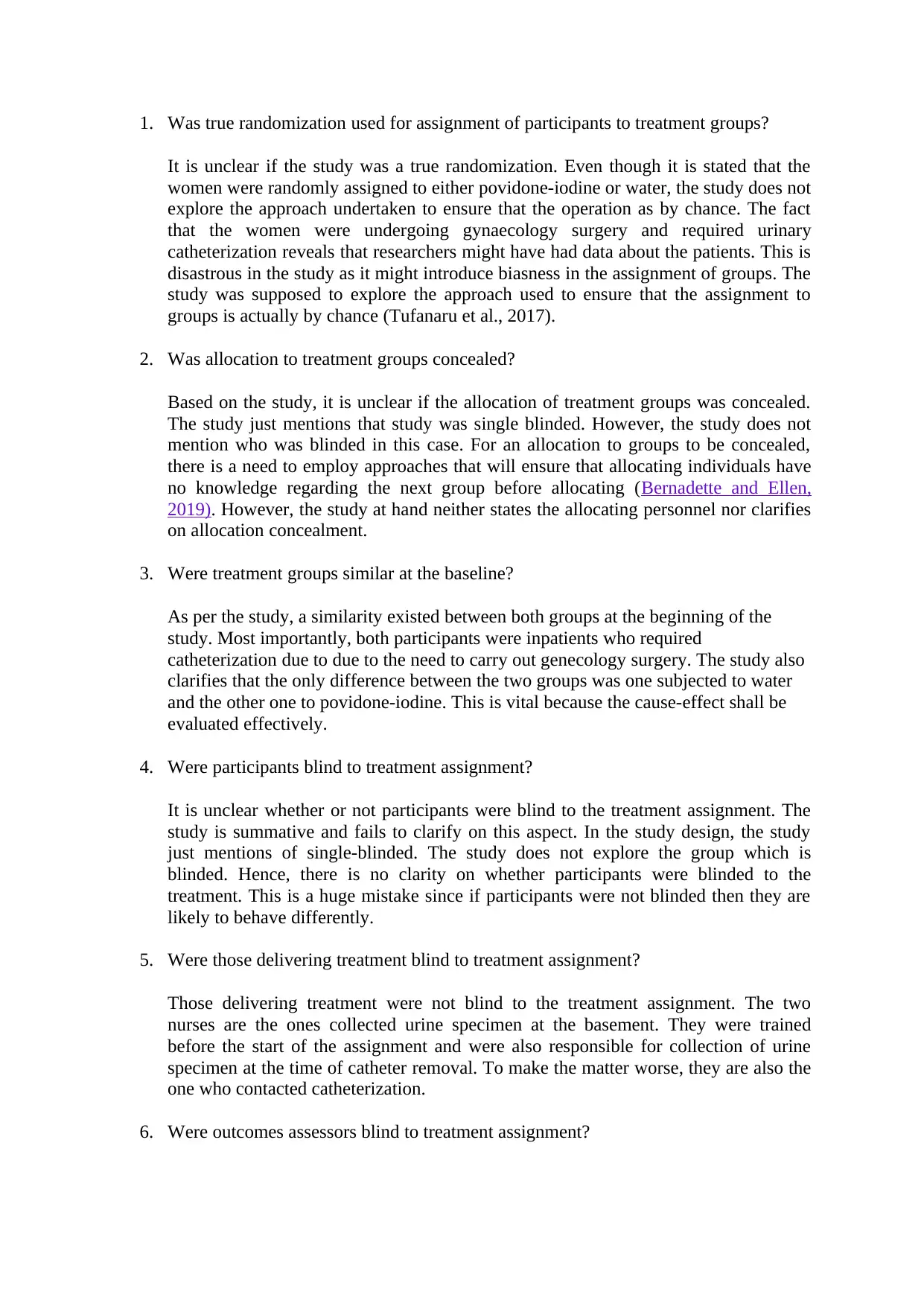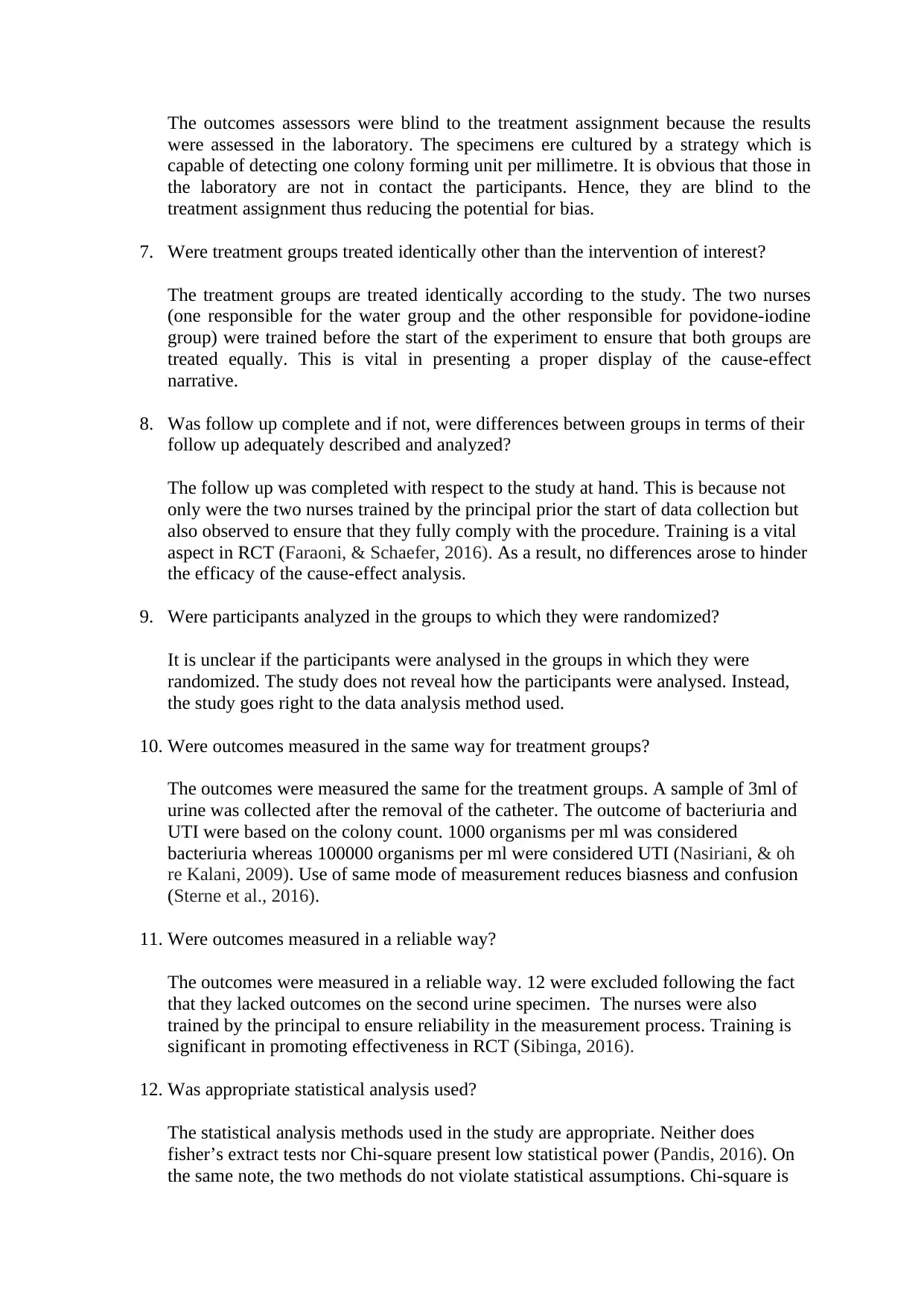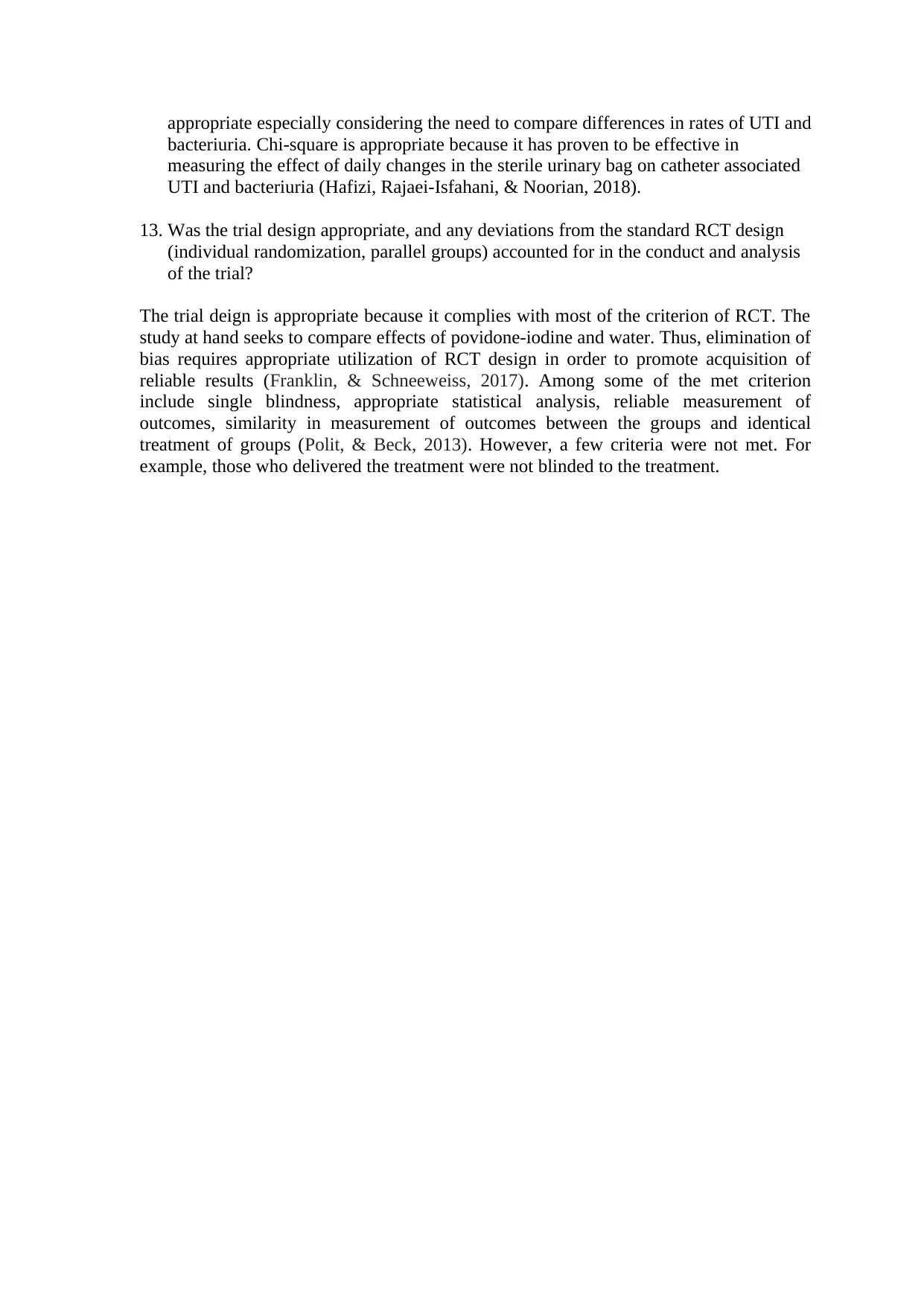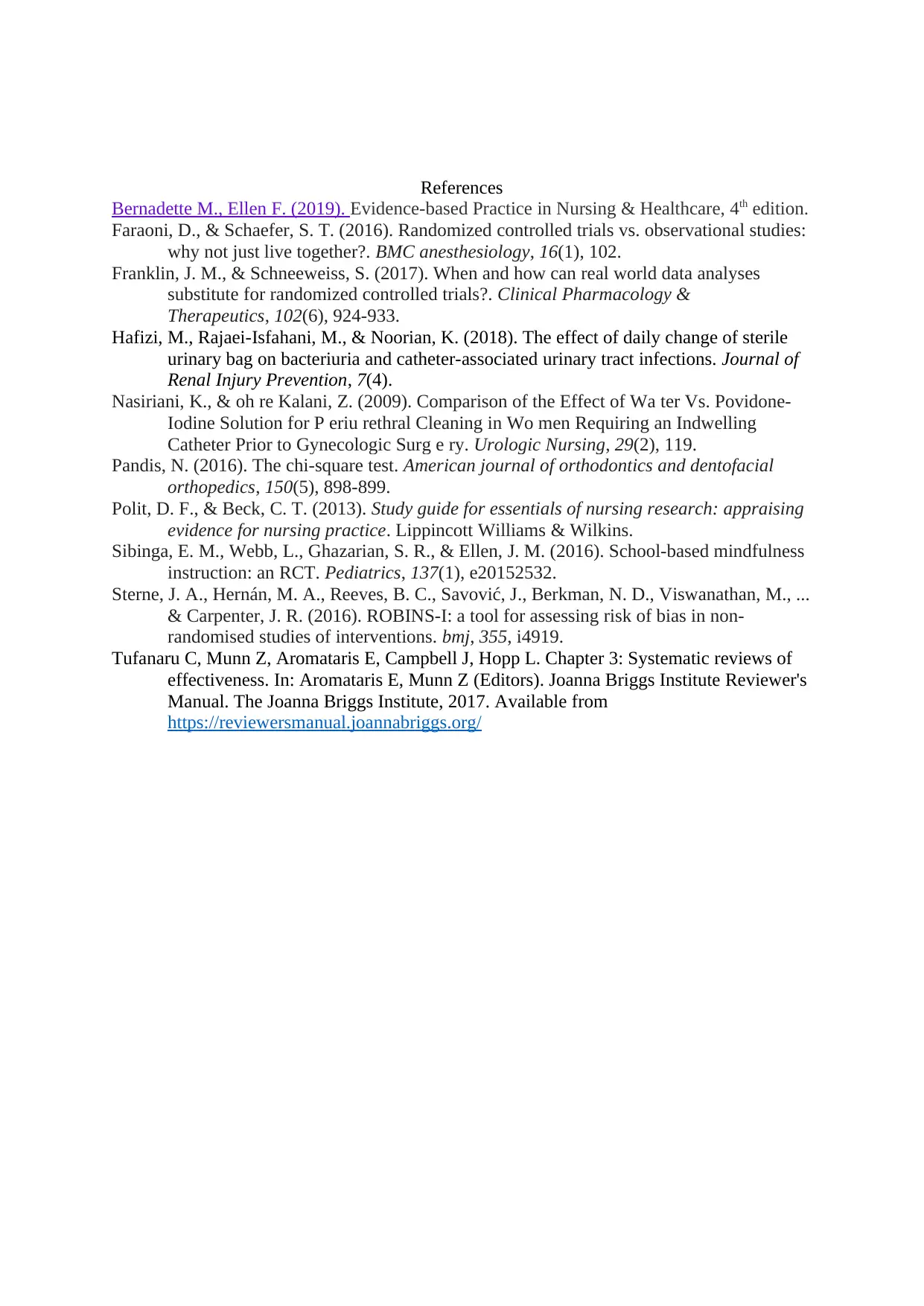Evaluation of a Randomized Controlled Trial using JBI Checklist
VerifiedAdded on 2022/08/11
|4
|1598
|272
Homework Assignment
AI Summary
This assignment critically appraises a randomized controlled trial (RCT) investigating the effects of povidone-iodine versus water for periurethral cleaning in women undergoing gynecologic surgery and requiring urinary catheterization, using the Joanna Briggs Institute (JBI) checklist. The evaluation assesses key aspects of the RCT's design and conduct. The assessment determines whether true randomization was used, the allocation concealment, and the similarity of treatment groups at baseline. The study's blinding procedures for participants, treatment providers, and outcome assessors are examined, along with the identical treatment of groups other than the intervention of interest, and the completeness of follow-up. The assignment also analyzes whether participants were analyzed in the groups to which they were randomized, if outcomes were measured consistently, and if appropriate statistical analyses were employed. Finally, the study's overall design and adherence to RCT standards are evaluated, highlighting strengths, weaknesses, and potential biases. The study reveals that the RCT was single-blinded. The outcome assessors were blind to treatment assignment, and that follow up was completed. The treatment groups were treated identically other than the intervention of interest.

1. Was true randomization used for assignment of participants to treatment groups?
It is unclear if the study was a true randomization. Even though it is stated that the
women were randomly assigned to either povidone-iodine or water, the study does not
explore the approach undertaken to ensure that the operation as by chance. The fact
that the women were undergoing gynaecology surgery and required urinary
catheterization reveals that researchers might have had data about the patients. This is
disastrous in the study as it might introduce biasness in the assignment of groups. The
study was supposed to explore the approach used to ensure that the assignment to
groups is actually by chance (Tufanaru et al., 2017).
2. Was allocation to treatment groups concealed?
Based on the study, it is unclear if the allocation of treatment groups was concealed.
The study just mentions that study was single blinded. However, the study does not
mention who was blinded in this case. For an allocation to groups to be concealed,
there is a need to employ approaches that will ensure that allocating individuals have
no knowledge regarding the next group before allocating (Bernadette and Ellen,
2019). However, the study at hand neither states the allocating personnel nor clarifies
on allocation concealment.
3. Were treatment groups similar at the baseline?
As per the study, a similarity existed between both groups at the beginning of the
study. Most importantly, both participants were inpatients who required
catheterization due to due to the need to carry out genecology surgery. The study also
clarifies that the only difference between the two groups was one subjected to water
and the other one to povidone-iodine. This is vital because the cause-effect shall be
evaluated effectively.
4. Were participants blind to treatment assignment?
It is unclear whether or not participants were blind to the treatment assignment. The
study is summative and fails to clarify on this aspect. In the study design, the study
just mentions of single-blinded. The study does not explore the group which is
blinded. Hence, there is no clarity on whether participants were blinded to the
treatment. This is a huge mistake since if participants were not blinded then they are
likely to behave differently.
5. Were those delivering treatment blind to treatment assignment?
Those delivering treatment were not blind to the treatment assignment. The two
nurses are the ones collected urine specimen at the basement. They were trained
before the start of the assignment and were also responsible for collection of urine
specimen at the time of catheter removal. To make the matter worse, they are also the
one who contacted catheterization.
6. Were outcomes assessors blind to treatment assignment?
It is unclear if the study was a true randomization. Even though it is stated that the
women were randomly assigned to either povidone-iodine or water, the study does not
explore the approach undertaken to ensure that the operation as by chance. The fact
that the women were undergoing gynaecology surgery and required urinary
catheterization reveals that researchers might have had data about the patients. This is
disastrous in the study as it might introduce biasness in the assignment of groups. The
study was supposed to explore the approach used to ensure that the assignment to
groups is actually by chance (Tufanaru et al., 2017).
2. Was allocation to treatment groups concealed?
Based on the study, it is unclear if the allocation of treatment groups was concealed.
The study just mentions that study was single blinded. However, the study does not
mention who was blinded in this case. For an allocation to groups to be concealed,
there is a need to employ approaches that will ensure that allocating individuals have
no knowledge regarding the next group before allocating (Bernadette and Ellen,
2019). However, the study at hand neither states the allocating personnel nor clarifies
on allocation concealment.
3. Were treatment groups similar at the baseline?
As per the study, a similarity existed between both groups at the beginning of the
study. Most importantly, both participants were inpatients who required
catheterization due to due to the need to carry out genecology surgery. The study also
clarifies that the only difference between the two groups was one subjected to water
and the other one to povidone-iodine. This is vital because the cause-effect shall be
evaluated effectively.
4. Were participants blind to treatment assignment?
It is unclear whether or not participants were blind to the treatment assignment. The
study is summative and fails to clarify on this aspect. In the study design, the study
just mentions of single-blinded. The study does not explore the group which is
blinded. Hence, there is no clarity on whether participants were blinded to the
treatment. This is a huge mistake since if participants were not blinded then they are
likely to behave differently.
5. Were those delivering treatment blind to treatment assignment?
Those delivering treatment were not blind to the treatment assignment. The two
nurses are the ones collected urine specimen at the basement. They were trained
before the start of the assignment and were also responsible for collection of urine
specimen at the time of catheter removal. To make the matter worse, they are also the
one who contacted catheterization.
6. Were outcomes assessors blind to treatment assignment?
Paraphrase This Document
Need a fresh take? Get an instant paraphrase of this document with our AI Paraphraser

The outcomes assessors were blind to the treatment assignment because the results
were assessed in the laboratory. The specimens ere cultured by a strategy which is
capable of detecting one colony forming unit per millimetre. It is obvious that those in
the laboratory are not in contact the participants. Hence, they are blind to the
treatment assignment thus reducing the potential for bias.
7. Were treatment groups treated identically other than the intervention of interest?
The treatment groups are treated identically according to the study. The two nurses
(one responsible for the water group and the other responsible for povidone-iodine
group) were trained before the start of the experiment to ensure that both groups are
treated equally. This is vital in presenting a proper display of the cause-effect
narrative.
8. Was follow up complete and if not, were differences between groups in terms of their
follow up adequately described and analyzed?
The follow up was completed with respect to the study at hand. This is because not
only were the two nurses trained by the principal prior the start of data collection but
also observed to ensure that they fully comply with the procedure. Training is a vital
aspect in RCT (Faraoni, & Schaefer, 2016). As a result, no differences arose to hinder
the efficacy of the cause-effect analysis.
9. Were participants analyzed in the groups to which they were randomized?
It is unclear if the participants were analysed in the groups in which they were
randomized. The study does not reveal how the participants were analysed. Instead,
the study goes right to the data analysis method used.
10. Were outcomes measured in the same way for treatment groups?
The outcomes were measured the same for the treatment groups. A sample of 3ml of
urine was collected after the removal of the catheter. The outcome of bacteriuria and
UTI were based on the colony count. 1000 organisms per ml was considered
bacteriuria whereas 100000 organisms per ml were considered UTI (Nasiriani, & oh
re Kalani, 2009). Use of same mode of measurement reduces biasness and confusion
(Sterne et al., 2016).
11. Were outcomes measured in a reliable way?
The outcomes were measured in a reliable way. 12 were excluded following the fact
that they lacked outcomes on the second urine specimen. The nurses were also
trained by the principal to ensure reliability in the measurement process. Training is
significant in promoting effectiveness in RCT (Sibinga, 2016).
12. Was appropriate statistical analysis used?
The statistical analysis methods used in the study are appropriate. Neither does
fisher’s extract tests nor Chi-square present low statistical power (Pandis, 2016). On
the same note, the two methods do not violate statistical assumptions. Chi-square is
were assessed in the laboratory. The specimens ere cultured by a strategy which is
capable of detecting one colony forming unit per millimetre. It is obvious that those in
the laboratory are not in contact the participants. Hence, they are blind to the
treatment assignment thus reducing the potential for bias.
7. Were treatment groups treated identically other than the intervention of interest?
The treatment groups are treated identically according to the study. The two nurses
(one responsible for the water group and the other responsible for povidone-iodine
group) were trained before the start of the experiment to ensure that both groups are
treated equally. This is vital in presenting a proper display of the cause-effect
narrative.
8. Was follow up complete and if not, were differences between groups in terms of their
follow up adequately described and analyzed?
The follow up was completed with respect to the study at hand. This is because not
only were the two nurses trained by the principal prior the start of data collection but
also observed to ensure that they fully comply with the procedure. Training is a vital
aspect in RCT (Faraoni, & Schaefer, 2016). As a result, no differences arose to hinder
the efficacy of the cause-effect analysis.
9. Were participants analyzed in the groups to which they were randomized?
It is unclear if the participants were analysed in the groups in which they were
randomized. The study does not reveal how the participants were analysed. Instead,
the study goes right to the data analysis method used.
10. Were outcomes measured in the same way for treatment groups?
The outcomes were measured the same for the treatment groups. A sample of 3ml of
urine was collected after the removal of the catheter. The outcome of bacteriuria and
UTI were based on the colony count. 1000 organisms per ml was considered
bacteriuria whereas 100000 organisms per ml were considered UTI (Nasiriani, & oh
re Kalani, 2009). Use of same mode of measurement reduces biasness and confusion
(Sterne et al., 2016).
11. Were outcomes measured in a reliable way?
The outcomes were measured in a reliable way. 12 were excluded following the fact
that they lacked outcomes on the second urine specimen. The nurses were also
trained by the principal to ensure reliability in the measurement process. Training is
significant in promoting effectiveness in RCT (Sibinga, 2016).
12. Was appropriate statistical analysis used?
The statistical analysis methods used in the study are appropriate. Neither does
fisher’s extract tests nor Chi-square present low statistical power (Pandis, 2016). On
the same note, the two methods do not violate statistical assumptions. Chi-square is

appropriate especially considering the need to compare differences in rates of UTI and
bacteriuria. Chi-square is appropriate because it has proven to be effective in
measuring the effect of daily changes in the sterile urinary bag on catheter associated
UTI and bacteriuria (Hafizi, Rajaei-Isfahani, & Noorian, 2018).
13. Was the trial design appropriate, and any deviations from the standard RCT design
(individual randomization, parallel groups) accounted for in the conduct and analysis
of the trial?
The trial deign is appropriate because it complies with most of the criterion of RCT. The
study at hand seeks to compare effects of povidone-iodine and water. Thus, elimination of
bias requires appropriate utilization of RCT design in order to promote acquisition of
reliable results (Franklin, & Schneeweiss, 2017). Among some of the met criterion
include single blindness, appropriate statistical analysis, reliable measurement of
outcomes, similarity in measurement of outcomes between the groups and identical
treatment of groups (Polit, & Beck, 2013). However, a few criteria were not met. For
example, those who delivered the treatment were not blinded to the treatment.
bacteriuria. Chi-square is appropriate because it has proven to be effective in
measuring the effect of daily changes in the sterile urinary bag on catheter associated
UTI and bacteriuria (Hafizi, Rajaei-Isfahani, & Noorian, 2018).
13. Was the trial design appropriate, and any deviations from the standard RCT design
(individual randomization, parallel groups) accounted for in the conduct and analysis
of the trial?
The trial deign is appropriate because it complies with most of the criterion of RCT. The
study at hand seeks to compare effects of povidone-iodine and water. Thus, elimination of
bias requires appropriate utilization of RCT design in order to promote acquisition of
reliable results (Franklin, & Schneeweiss, 2017). Among some of the met criterion
include single blindness, appropriate statistical analysis, reliable measurement of
outcomes, similarity in measurement of outcomes between the groups and identical
treatment of groups (Polit, & Beck, 2013). However, a few criteria were not met. For
example, those who delivered the treatment were not blinded to the treatment.
⊘ This is a preview!⊘
Do you want full access?
Subscribe today to unlock all pages.

Trusted by 1+ million students worldwide

References
Bernadette M., Ellen F. (2019). Evidence-based Practice in Nursing & Healthcare, 4th edition.
Faraoni, D., & Schaefer, S. T. (2016). Randomized controlled trials vs. observational studies:
why not just live together?. BMC anesthesiology, 16(1), 102.
Franklin, J. M., & Schneeweiss, S. (2017). When and how can real world data analyses
substitute for randomized controlled trials?. Clinical Pharmacology &
Therapeutics, 102(6), 924-933.
Hafizi, M., Rajaei-Isfahani, M., & Noorian, K. (2018). The effect of daily change of sterile
urinary bag on bacteriuria and catheter-associated urinary tract infections. Journal of
Renal Injury Prevention, 7(4).
Nasiriani, K., & oh re Kalani, Z. (2009). Comparison of the Effect of Wa ter Vs. Povidone-
Iodine Solution for P eriu rethral Cleaning in Wo men Requiring an Indwelling
Catheter Prior to Gynecologic Surg e ry. Urologic Nursing, 29(2), 119.
Pandis, N. (2016). The chi-square test. American journal of orthodontics and dentofacial
orthopedics, 150(5), 898-899.
Polit, D. F., & Beck, C. T. (2013). Study guide for essentials of nursing research: appraising
evidence for nursing practice. Lippincott Williams & Wilkins.
Sibinga, E. M., Webb, L., Ghazarian, S. R., & Ellen, J. M. (2016). School-based mindfulness
instruction: an RCT. Pediatrics, 137(1), e20152532.
Sterne, J. A., Hernán, M. A., Reeves, B. C., Savović, J., Berkman, N. D., Viswanathan, M., ...
& Carpenter, J. R. (2016). ROBINS-I: a tool for assessing risk of bias in non-
randomised studies of interventions. bmj, 355, i4919.
Tufanaru C, Munn Z, Aromataris E, Campbell J, Hopp L. Chapter 3: Systematic reviews of
effectiveness. In: Aromataris E, Munn Z (Editors). Joanna Briggs Institute Reviewer's
Manual. The Joanna Briggs Institute, 2017. Available from
https://reviewersmanual.joannabriggs.org/
Bernadette M., Ellen F. (2019). Evidence-based Practice in Nursing & Healthcare, 4th edition.
Faraoni, D., & Schaefer, S. T. (2016). Randomized controlled trials vs. observational studies:
why not just live together?. BMC anesthesiology, 16(1), 102.
Franklin, J. M., & Schneeweiss, S. (2017). When and how can real world data analyses
substitute for randomized controlled trials?. Clinical Pharmacology &
Therapeutics, 102(6), 924-933.
Hafizi, M., Rajaei-Isfahani, M., & Noorian, K. (2018). The effect of daily change of sterile
urinary bag on bacteriuria and catheter-associated urinary tract infections. Journal of
Renal Injury Prevention, 7(4).
Nasiriani, K., & oh re Kalani, Z. (2009). Comparison of the Effect of Wa ter Vs. Povidone-
Iodine Solution for P eriu rethral Cleaning in Wo men Requiring an Indwelling
Catheter Prior to Gynecologic Surg e ry. Urologic Nursing, 29(2), 119.
Pandis, N. (2016). The chi-square test. American journal of orthodontics and dentofacial
orthopedics, 150(5), 898-899.
Polit, D. F., & Beck, C. T. (2013). Study guide for essentials of nursing research: appraising
evidence for nursing practice. Lippincott Williams & Wilkins.
Sibinga, E. M., Webb, L., Ghazarian, S. R., & Ellen, J. M. (2016). School-based mindfulness
instruction: an RCT. Pediatrics, 137(1), e20152532.
Sterne, J. A., Hernán, M. A., Reeves, B. C., Savović, J., Berkman, N. D., Viswanathan, M., ...
& Carpenter, J. R. (2016). ROBINS-I: a tool for assessing risk of bias in non-
randomised studies of interventions. bmj, 355, i4919.
Tufanaru C, Munn Z, Aromataris E, Campbell J, Hopp L. Chapter 3: Systematic reviews of
effectiveness. In: Aromataris E, Munn Z (Editors). Joanna Briggs Institute Reviewer's
Manual. The Joanna Briggs Institute, 2017. Available from
https://reviewersmanual.joannabriggs.org/
1 out of 4
Related Documents
Your All-in-One AI-Powered Toolkit for Academic Success.
+13062052269
info@desklib.com
Available 24*7 on WhatsApp / Email
![[object Object]](/_next/static/media/star-bottom.7253800d.svg)
Unlock your academic potential
Copyright © 2020–2025 A2Z Services. All Rights Reserved. Developed and managed by ZUCOL.





